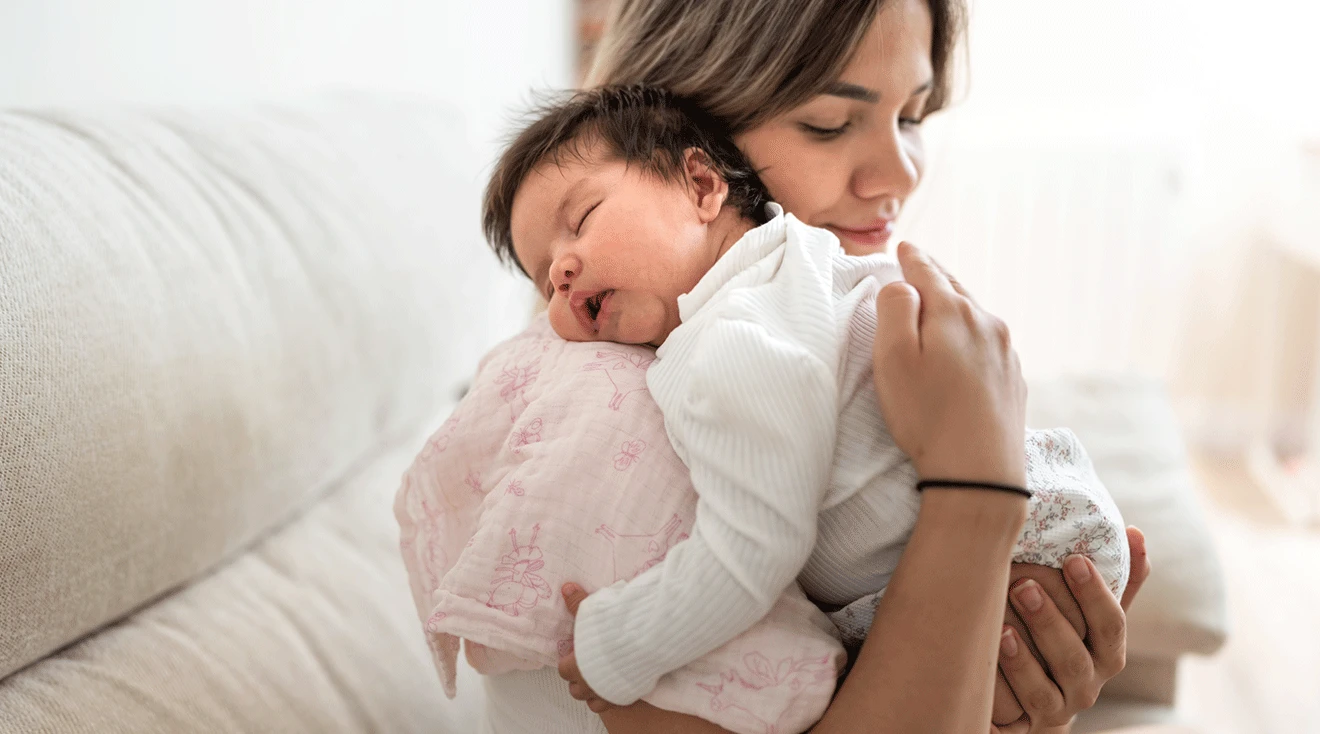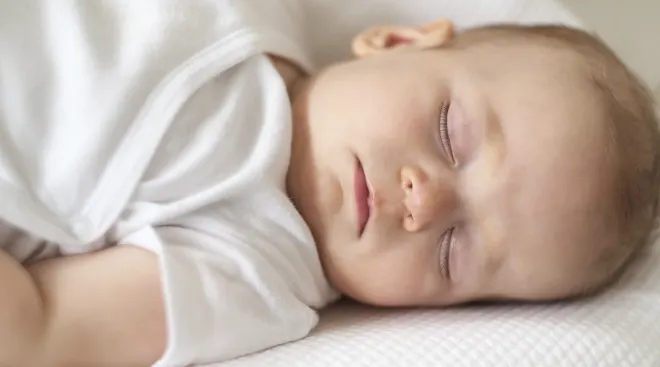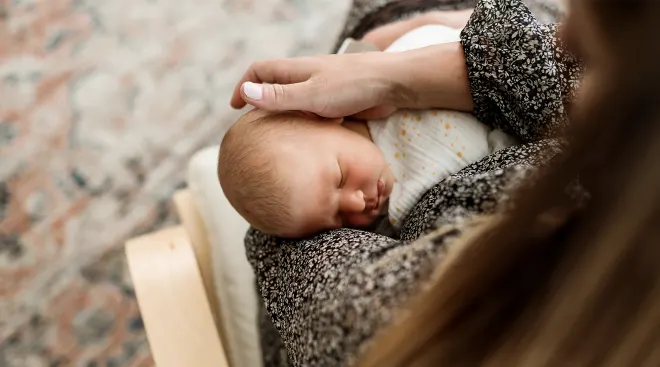The Benefits and Drawbacks of Contact Naps for Newborns and Infants
Your phone battery is at 2 percent, your arm went numb ages ago and you desperately need to pee—but baby is finally sleeping soundly on your chest, so you don’t dare move. While social media calls these cozy moments “contact naps,” parents have been snuggling sleeping babies since the dawn of time. Contact naps for newborns are especially common, but today’s parents face modern questions: How do contact naps fit with safe sleep guidelines? When do contact naps help—and when might they hinder—healthy sleep habits? Here’s what sleep experts and experienced parents want you to know about contact napping—plus what to do if you’re nap trapped.
Simply put, contact napping is when your little one snoozes while nestled against your body—whether sprawled on your chest or cuddled in your arms. Though it might seem similar to co-sleeping, contact napping has two distinct features: the caregiver stays awake, and there’s always direct physical contact between a caregiver and baby.
Yes, contact naps are typically safe—as long as you take some important precautions. “The only safe way to contact nap is if your baby is the only one sleeping,” says pediatrician and sleep expert Harvey Karp, MD, bestselling author of The Happiest Baby on the Block. “When you’re sleeping, you’re not in control, which increases the risk of baby slipping into an unsafe position, possibly blocking their airway or even falling—especially if you’re on a couch or in an armchair.” And that’s a real danger. A UK report found that over 40 percent of parents have fallen asleep on a sofa or glider with their baby. It’s even a risk in hospitals: A 2019 study in Pediatrics reported that 36 to 66 percent of all in-hospital neonatal falls involved caregivers nodding off—often during feeding sessions.
“When my daughters were younger, I had safety concerns about contact napping,” says Lauren, mom of two in Atlanta. “I was so tired and always scared I’d nod off and drop the baby.” While Lauren never slept through a contact nap, she did rest her eyes when someone else was present. “Thankfully, just closing my eyes sometimes was enough for a reset,” she says.
While research specific to contact napping is limited, studies of kangaroo care have shown clear benefits to skin-to-skin action, such as reduced crying and improved nursing success, according to the American Academy of Pediatrics (AAP). “While they’re not necessarily equivalent—kangaroo care [also] requires skin-to-skin contact. They are definitely similar in practice and benefits,” says sleep consultant Carrie Bruno, RN, IBCLC, founder of The Mama Coach, a network of nurses and nurse practitioners supporting families across North America. Both practices support the fourth trimester theory, which is a period of roughly three months when babies need close contact to feel secure, much like they felt in the womb.
Karp, who popularized the notion of the fourth trimester over 20 years ago, agrees: “Contact naps can foster bonding and help babies feel safe, secure and calm, which can support longer, more restful sleep.” Plus, the AAP reports that practices like kangaroo care may increase the time babies spend in deep sleep, and Bruno adds that contact naps appear to help with active sleep (aka REM sleep), too.
“Whether we’re talking about newborns who spend up to 75 percent of sleep time in active sleep, or older babies cycling through sleep stages, when babies are held during naps, they often fall back to sleep when they stir,” says Bruno. “If they shift or wake, whoever is holding them instinctively pats their bum, moves and lulls them back to sleep.” In contrast, babies alone in their crib must self-soothe on their own—a skill some master quickly, while others need more time.
Hannah, a mom of one in Ludlow, Massachusetts, saw the benefits of contact naps firsthand. “My baby would hardly sleep during the day, but on my chest, she’d nap up to two hours,” she recalls. Lauren, an Atlanta-based mom of two, appreciates contact napping, but has a different experience: “Right now, my baby contact naps for about 30 to 45 minutes. And while that’s about what newborn naps are anyway, contact naps are definitely shorter than naps anywhere else,” she says.
All that said, some possible key benefits of contact napping, according to experts, include:
- Promotes longer, deeper sleep in some babies
- Supports parent-child bonding
- May reduce crying
- May support breastfeeding success
- Mimics familiar womb environment
- Provides comfort during the fourth trimester
- Helps babies feel calm and secure
Contact naps are not for everyone—and they don’t have to be! “I can’t tell you if contact naps are good or bad,” says Bruno. “That’s something the individual who’s primarily doing the contact naps gets to decide.” After all, one person’s drawback is another’s perk.
Take the “nap trap,” for example. Victoria, a mom of two in Upton, Massachusetts, initially struggled with this: “As much as I wanted to relish newborn contact naps, I felt like I was missing opportunities to do laundry, work out and clean. It definitely ate at me during those early months.” But with her third baby on the way, her perspective has shifted. “This time, I’m going to soak up all the cuddles. Dishes and laundry will eventually get done. Time is fleeting, so I plan to contact nap and just let the dishes pile up!”
Beyond being temporarily marooned on the sofa—and the safety risks if you doze off—many parents worry about the transition from contact napping to crib napping. It’s a valid concern, says Bruno. “The longer you contact nap, the longer it’ll potentially take for baby to learn independent sleep,” she says.
Victoria experienced this firsthand: “Contact napping created a close bond and made nap times soothing, but it made it tough to transition to independent sleep once they got older. They were so used to the comfort of being held that getting them to sleep alone took a lot of time and patience.”
Hannah faced similar challenges. “When I tried to transition her into her bassinet, she’d cry within 15 minutes. It took until around 5 or 6 months for baby to take consistent two-hour naps in her crib.” It’s worth noting, however, that some babies adapt easily to both styles.
“Don’t think if you haven’t stopped by 6 months that you’ve made a huge mistake,” says Bruno. “Contact napping does not negatively impact baby’s development. So deciding when to stop is all about how you feel.” Translation: If you’re ready to stop contact napping, then it’s time to stop. That said, Bruno notes that transitioning “around 4 months will most likely be easier than, say, waiting until 7 months, when many babies drop to two naps.”
Here are some of the best way to set baby up for a successful transition to independent napping:
Make white noise your bridge
Start using white noise during contact naps, then continue with crib sleep. These familiar sounds remind babies of the womb and become a consistent sleep cue that helps them drift off in any environment, says Karp.
Adjust feeding patterns
After the two-week mark, avoid letting baby fall asleep during a feed. "Once baby’s sucking pattern moves from big sucks and swallows to a shallow suck, they’re done and it’s time to put them down,” says Bruno. Dozing at the breast or bottle creates a micro nap, which disrupts the sleep pressure needed for a successful nap.
Wake baby up
While this seems like the worst advice ever, hear Karp out: “After baby falls asleep in your arms, place them in their crib or bassinet, and then tickle their toes to wake them just a little bit,” he says. “Most babies drift right back to sleep, and those few seconds of drowsy waking are your little one’s first steps to learning how to self-soothe somewhere other than your arms.”
Master the 5 S’s
Karp’s famous 5 S’s—swaddling, holding in the side/stomach position, shushing, swinging and sucking—work to activate baby’s natural calming response. Think of it as their built-in switch for sleep. At naptime, use a swaddle or sleep sack (depending on their rolling status), white noise, and a pacifier, if they take one. Bruno suggests keeping a small stool by the crib “so you can lean in close, gently shush in their ear and touch your cheek to theirs,” she says. “The more you practice this, the better they’ll do.”
Start with nighttime success
“Sleep improves in succession, which means bedtime typically improves first and naptime is last,” explains Bruno. Use this natural pattern to your advantage by practicing crib transitions at bedtime, when baby’s sleep hormones are working with you. “After the newborn period, babies start secreting the sleep hormone melatonin at night, so now bedtime-tired looks different than rest-of-the-day tired,” explains Bruno. As baby learns to fall asleep independently at night, these skills will naturally extend to nap time.
Partner with your daycare
If your baby attends daycare, use this transition to your advantage. “We tried to stop contact napping around 6 months, and starting daycare at the same time really helped,” says Victoria. “They gave us some tips about how they structure naps at daycare, and we knew that if we kept it consistent at home, breaking contact naps might be easier—and it was.”
Frequently Asked Questions
Can you spoil a baby with contact naps?
Never worry about too many snuggles—there’s no such thing! Babies naturally crave closeness. “It’s how they’re wired,” says Karp. “While some can develop a strong preference for contact naps, this isn’t a ‘bad’ thing.” The bottom line is: All babies can transition from contact napping to sleeping in their safe sleep space.
Do babies outgrow contact napping on their own?
“There’s no real research on when infants outgrow contact naps,” says Bruno. Each baby follows their own timeline. Parents worried about endless contact naps can take comfort in Karp’s perspective: “As babies grow and mature, they’ll become more comfortable, especially with a bit of help from white noise and loveys.”
Should you wear baby for contact naps?
If your baby falls asleep in an infant carrier or sling, the AAP recommends moving your little one to a safe sleep space, like a crib, as soon as possible. The reason? “In a carrier, you can’t necessarily see if your baby’s nose and mouth are obstructed,” says Bruno. “That means, the safest way to contact nap is to hold your baby and be awake and paying attention.” But if you are out and about, with a baby snoozing in their baby carrier, don’t panic. Instead, “be sure your baby’s face is visible and their chin isn’t pressed to their chest,” advises Karp.
The bottom line: “Babies love contact naps! The soft warmth of your body, the gentle rise and fall of your chest, the sound of your heart pumping and your breathing—it’s like home for them,” says Karp. While some parents worry about creating “bad habits,” remember that all babies eventually learn to sleep independently. The key is finding what works for your family—whether that’s embracing contact naps during the newborn phase, gradually transitioning to crib naps or using a mix of both approaches. Trust your instincts, prioritize safe sleep practices and if you’re ready to help your little one transition to solo naps, “start small, with just one nap a day in the crib and build from there,” suggests Karp. “The goal isn’t to eliminate snuggles, but to help your baby feel secure both in your arms and on their own.”
Please note: The Bump and the materials and information it contains are not intended to, and do not constitute, medical or other health advice or diagnosis and should not be used as such. You should always consult with a qualified physician or health professional about your specific circumstances.
Plus, more from The Bump:
Carrie Bruno, RN, IBCLC, is a registered nurse, lactation consultant and the founder of The Mama Coach, a network of nurses and nurse practitioners supporting families across North America.
Harvey Karp, MD, is the bestselling author of The Happiest Baby on the Block. He serves on the faculty of the USC School of Medicine and is a fellow of the American Academy of Pediatrics (AAP). After decades of treating patients, Karp founded Happiest Baby, a smart-tech and parenting solutions company.
The Lullaby Trust, New survey shows 9 in 10 parents co-sleep but less than half know how to reduce the risk of SIDS, March 2023
Pediatrics, American Academy of Pediatrics (AAP), In-hospital Neonatal Falls: An Unintended Consequence of Efforts to Improve Breastfeeding, 2018
American Academy of Pediatrics (AAP), Skin-to-Skin Care, February 2024
American Academy of Pediatrics (AAP), Safe Sleep and Your Baby: How Parents Can Reduce the Risk of SIDS and Suffocation, June 2022
Learn how we ensure the accuracy of our content through our editorial and medical review process.
Navigate forward to interact with the calendar and select a date. Press the question mark key to get the keyboard shortcuts for changing dates.




















































